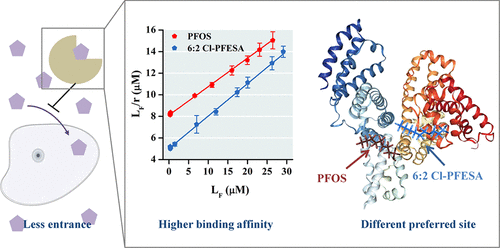当前位置:
X-MOL 学术
›
Chem. Res. Toxicol.
›
论文详情
Our official English website, www.x-mol.net, welcomes your
feedback! (Note: you will need to create a separate account there.)
Interactions of Perfluorooctanesulfonate and 6:2 Chlorinated Polyfluorinated Ether Sulfonate with Human Serum Albumin: A Comparative Study.
Chemical Research in Toxicology ( IF 3.7 ) Pub Date : 2020-05-19 , DOI: 10.1021/acs.chemrestox.0c00075 Nan Sheng 1 , Jinghua Wang 1 , Yong Guo 2 , Jianshe Wang 1 , Jiayin Dai 1
Chemical Research in Toxicology ( IF 3.7 ) Pub Date : 2020-05-19 , DOI: 10.1021/acs.chemrestox.0c00075 Nan Sheng 1 , Jinghua Wang 1 , Yong Guo 2 , Jianshe Wang 1 , Jiayin Dai 1
Affiliation

|
6:2 Chlorinated polyfluorinated ether sulfonate (6:2 Cl-PFESA) possesses a similar structure to perfluorooctanesulfonate (PFOS) and is the third most important polyfluoroalkyl/perfluoroalkyl substance (PFAS) found in the general population of China. Studies have indicated that 6:2 Cl-PFESA exhibits a stronger bioaccumulative and toxicological potential than PFOS and is thus of considerable environmental concern. Here, the binding characteristics of PFOS and 6:2 Cl-PFESA to human serum albumin (HSA) were explored based on in vitro and in silico methods. In the cell uptake assays, supplementation of HSA in the culture medium hindered diffusion of PFOS and 6:2 Cl-PFESA from the medium into cells. With the addition of 0.5, 10, and 200 μM HSA in the culture medium, the PFOS concentration in cells decreased by 21.4%, 78.1%, and 92.8%, whereas the 6:2 Cl-PFESA concentration in cells decreased by 28.4%, 84.4%, and 93.9%, respectively. Although no statistically significant difference between the reduction of PFOS and 6:2 Cl-PFESA was observed with 200 μM HSA in medium, the significant decrease in cellular 6:2 Cl-PFESA than PFOS after addition of 0.5 and 10 μM HSA implied that 6:2 Cl-PFESA had a stronger binding affinity than PFOS to HSA. Ultrafiltration centrifugation also suggested that 6:2 Cl-PFESA (Kd = 16.7 μM) had a higher affinity than PFOS (Kd = 30.7 μM) to HSA, though the binding molar ratios were similar, with 1 M HSA binding to 3–4 M PFOS/6:2 Cl-PFESA. Limited proteolysis further identified the core HSA peptides that bind to PFOS (peptide II, aa 189–457) and 6:2 Cl-PFESA (peptide I, aa 39–310). Using purified core peptides, 6:2 Cl-PFESA showed a stronger binding affinity than PFOS to both peptides I and II. The binding modes indicated that the chlorine and oxygen atoms in 6:2 Cl-PFESA were likely responsible for its preferential binding to Sudlow site I than to Trp214 or Sudlow site II, with the latter being the optimal binding site for PFOS. Overall, the stronger binding affinity of 6:2 Cl-PFESA to HSA may contribute to its higher bioaccumulation potential than PFOS.
更新日期:2020-05-19


















































 京公网安备 11010802027423号
京公网安备 11010802027423号